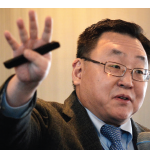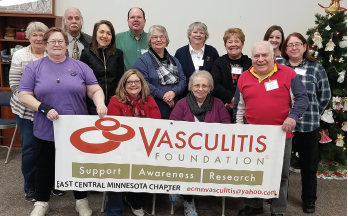SEATTLE—At the first regional vasculitis patient conference ever held in the Pacific Northwest, a panoramic view of Mt. Rainier on a clear January morning set the tone for a day of optimistic talks about recent successes against the various forms of blood vessel inflammation. One attendee at the Jan. 12 conference, sponsored by the Vasculitis Foundation in partnership with the University of Washington’s Division of Rheumatology, noted it was hard to tell patients from caregivers among the 100-plus participants—a definite sign of progress.
The success of recently approved treatments, such as the monoclonal antibodies rituximab (Rituxan) and mepolizumab (Nucala), and encouraging trial results of drug candidates, such as Avacopan (CCX168), have provided ample reasons for optimism. “The future is bright, I think, for vasculitis in general,” said Gregory C. Gardner, MD, FACP, Gilliland-Henderson Professor in Rheumatology at the University of Washington.

Dr. Seo
Featured speaker Philip Seo, MD, MHS, associate professor of medicine and director of the Johns Hopkins Vasculitis Center in Baltimore (and physician editor of The Rheumatologist [TR]), said some newer drugs may even become, “The Tina Feys of vasculitis,” a cheeky reference to the highly successful former cast member of Saturday Night Live.
Nevertheless, the humor and sunshine were tempered by more sobering stories of patients struggling to reclaim their lives after lengthy medical odysseys. Throughout the day, audience members shared tales of having to shop around for doctors, not having their symptoms taken seriously, lacking patient advocates, having to navigate a bewildering healthcare system alone, waiting years to receive the correct diagnosis, and even being forced to use spreadsheets to manage their own complex care.
Some came to the conference, one of more than 15 now held by the Vasculitis Foundation, to network and find mutual support. Some came to hear specific talks and solicit advice about their symptoms and care. And some came to deliver the message to rheumatologists that far more is needed to help support patients through what can still be an arduous and life-threatening ordeal. Just as attendees learned from the rheumatologists, the doctors received a firsthand look at patients’ main concerns.
In Search of Support & Community

Kami Schmidt with her daughter, Haley (left), who helped her start the support group.
Kami Schmidt, an attendee from Pine City, Minn., believes she’s had microscopic polyangiitis (MPA) for years. She remembers getting pneumonia nearly every fall, like clockwork, and experiencing frequent sinus issues. Her doctors always just knocked the infections back with prednisone—one reason she believes she wasn’t diagnosed sooner. “There does need to be more awareness,” she said in an interview with TR.
After nearly dying in 2009, Ms. Schmidt was finally diagnosed via a bronchoscopy and kidney biopsy and treated with intravenous prednisone, cyclophosphamide and plasmapheresis. “I told my doctor, ‘If I live through this, I want to do something to help other people going through this,’” recalled Ms. Schmidt.
Even though a team of seven doctors was caring for her at the time, Ms. Schmidt lacked a patient advocate or go-to person to ask her many questions. She decided to launch a support group “so people aren’t alone” and formed the East Central Minnesota Vasculitis Support Group, which regularly attracts more than 30 people to its quarterly meetings.
Ms. Schmidt traveled to the conference to report back to her group on the latest studies and treatment options. “I’m happy to see that there’s a lot of research,” she said. She also had high praise for the conference’s emphasis on education, empowerment and networking. “I think it’s great they connect people with vasculitis—people yearn for this. To have all of these people together, it’s amazing,” she said, looking around the room.
Sitting at the same table, Rosemary Brechtelsbauer told TR that she came to the conference from a nearby suburb to hear about new drug trials targeting her own rare condition, eosinophilic granulomatosis with polyangiitis (EGPA), as well as other forms of vasculitis. “I like to know everything,” she said. “I want to know what’s going on.”

Kami Schmidt (seated at lower left) with the East Central Minnesota Vasculitis Support Group in Minnesota.
Ms. Brechtelsbauer’s vasculitis began in 2009 with diffuse urticaria, but it took doctors several years to diagnose it, even though a skin biopsy revealed high eosinophil counts. She developed asthma, and then eosinophilic pneumonia. She tested negative for anti-neutrophil cytoplasmic antibodies (ANCA) but has since learned that only half of all patients have them.
At one point, she said, “I was on 10 different medications just to breathe,” she said. She was getting high-dose prednisone and finally began to improve a bit when doctors put her on omalizumab (Xolair). Even so, she endured five surgeries over five years. In the midst of one of them, she developed a new allergy to the anesthesia that nearly killed her. When she went into cardiac arrest, doctors had to perform CPR for two minutes to resuscitate her.
At a June 2015 vasculitis conference in Jacksonville, Fla., she had heard about promising new results from mepolizumab. When the FDA approved the drug in November 2015 to treat adults with eosinophilic asthma, “I was in my doctor’s office the next week, saying, ‘I want this,’” she recalled. “I knew about the Nucala approval before my immunologist.”
The combination of omalizumab and mepolizumab has “done wonders” for her EGPA as well, she said, and finally allowed her to taper off prednisone. “I’ve got a great team now,” she said, but she noted that she shopped around and assembled the providers on her own. Nevertheless, Ms. Brechtelsbauer said she feels lucky to be alive. “Right now, I’m doing great,” she said. “Biologics saved my life.” In addition to her wife and caregiver, Cheryl, she said, Facebook groups, national meetings and the Vasculitis Foundation have been strong pillars of support, especially given her ultra-rare disease. “To find your little tribe within that is amazing,” she said.
Advances on 3 Fronts

Rosemary Brechtelsbauer (left) and her wife, Cheryl (right) enjoying life at a Seattle Seahawks football game with the mascot.
In his opening talk, Dr. Seo grouped the emerging vasculitis therapies into three main categories: selective immune cell depletion, cytokine-based strategies and inhibition of immune targeting. Rituximab, in the first category, is a monoclonal anti-CD20 antibody that destroys B cells tagged with the CD-20 cell surface marker. B cell strategies are now standard for the treatment of both MPA and GPA (granulomatosis with polyangiitis). The two forms of ANCA-associated vasculitis attack small blood vessels, mainly in the lungs and kidneys. Rituximab received FDA approval to treat both conditions in 2011, and the drug is now used to treat cryoglobulinemic vasculitis, as well.
The second main treatment category, cytokine-based strategies, can “prevent the immune system from ganging up on you,” Dr. Seo said. Because cytokines instigate immune cells, targeting them can prevent a misguided attack. The pro-inflammatory cytokine IL-6, for example, spurs the production of infection-
fighting cells and proteins.
Mepolizumab works in much the same way by targeting interleukin (IL) 5, which Dr. Seo called “Miracle-Gro for eosinophils.” Weeding out eosinophils can knock back EGPA.
Giant cell arteritis (GCA), associated with blindness and stroke, may respond to anti-IL-6 inhibition. Tocilizumab (Actemra) gets rid of IL-6, and a phase 3 clinical trial (GiACTA) concluded that GCA patients on the drug were much less likely to flare as they tapered prednisone use, compared to patients on prednisone and a placebo.1 In response, the FDA approved tocilizumab for GCA in 2017. Not everyone has benefited: clinical trial data suggest that tocilizumab has been less effective in treating Takayasu’s arteritis, a large vessel vasculitis seen more often in younger women.
The third treatment category relies on inhibition of immune targeting, such as blocking or eliminating the antibodies used by the immune system to tag and attack blood vessels. “They can’t hurt you if they can’t find you,” Dr. Seo said. Recent reports from a large multinational study, PEXIVAS, suggest that plasmapheresis, or removing antibodies via plasma exchange, wasn’t effective in significantly reducing mortality or the risk of end-stage renal disease among ANCA-associated vasculitis patients, although the investigators stress the analysis is not yet complete.
Dr. Seo noted that researchers have reported more success, at least thus far, in getting rid of other immune tags, such as the protein fragment C5a. The phase 2 CLEAR trial tested a new ANCA-associated vasculitis drug candidate, Avacopan, which Dr. Seo compared with “Teflon for your blood vessels.” By preventing the C5a tag from sticking to them, researchers hypothesized that it could help eliminate the condition. In the CLEAR study, researchers reported that Avacopan plus standard medications did significantly better in getting patients into rapid remission than standard medications alone.
Better yet, Dr. Seo said, the drug may work without steroids—a statement that drew appreciative oohs from the audience. Steroids are “what make you cranky and want to throw toasters at people and tell them what you really think about them,” he said, to laughter and vigorous nodding. From an efficacy standpoint, he concluded, Avacopan may yet give rituximab a run for its money.
The PEXIVAS study likewise suggested high-dose oral glucocorticoids were no better than low-dose steroids in further improving the outcomes of patients treated with cyclophosphamide or rituximab. In other words, Dr. Seo said, the drugs have opened the possibility, for the first time, of treating vasculitis with much less or even no steroids. That assessment was especially popular with the audience.
In response to questions, Dr. Seo cautioned that rituximab carries a small but potentially serious risk for common variable immune deficiency (CVID), a disorder linked to low immunoglobulin levels that can disrupt someone’s ability to produce new antibodies. “It’s not a slam dunk to remain on rituximab forever,” he said.
New Clinics & Telling Symptoms
For patients with GCA, Ingeborg Sacksen, MD, FACP, clinical associate professor in the Division of Rheumatology at the University of Washington, described another advance in the form of a new fast-track clinic. The vasculitis can inflame the great vessels and dramatically reduce their blood carrying capacity—particularly the temporal and ophthalmic arteries—and cause relentless headaches and sudden, permanent vision loss in one eye, among its many potential symptoms.
In fact, Dr. Sacksen said, up to one-third of GCA patients will lose their vision and two-thirds will have distinct warning signs about one week prior to that loss. Quick treatment, then, is critical. “Time is vision,” she emphasized. Modeled after existing clinics in Europe, the university has set up its own fast-track clinic that includes a GCA hotline for physicians and a commitment to see patients within 24 hours for a medical evaluation.
Fortunately, ultrasound of the temporal and other arteries can reveal the halo sign, which is highly suggestive of GCA. “There’s nothing else in the world of ultrasound that looks like this,” Dr. Sacksen said. A positive ultrasound triggers immediate treatment with high-dose and sometimes intravenous steroids to prevent blindness. A negative ultrasound can still lead to treatment if doctors detect the presence of other worrisome signs, such as headaches and double vision. Once at-risk patients are treated with steroids, many can be managed with tocilizumab, the “new kid on the block,” she said.
Dr. Gardner said the University of Washington’s Division of Rheumatology has also started a once-a-month vasculitis clinic. He confirmed the university is trying to find a vasculitis-trained rheumatologist to head a dedicated vasculitis center and secure the necessary funding. “It’s in the early beginnings, and we’re looking to grow that,” he said.
In his talk, Dr. Gardner reviewed the main kinds of lung involvement in vasculitis, including bleeding, inflammation, fibrosis, nodules or cavities and blood vessel enlargement. Diagnosis of bleeding in the lungs or diffuse alveolar hemorrhage (DAH) can be made via a chest X-ray, more sensitive CT scan or bronchoscopy. Coughing up blood, he stressed, is a medical emergency that requires immediate attention.
Lung inflammation can present as lung infiltrates or a process that mimics pneumonia. “I’ve seen many patients who have been treated for pneumonia when they actually have lung vasculitis,” Dr. Gardner said. If the supposed pneumonia doesn’t improve, he said, doctors should seriously consider the possibility of vasculitis.
Pulmonary scar tissue, he added, is sometimes the first manifestation of vasculitis and may be marked by an increasing cough or shortness of breath. The key, Dr. Gardner emphasized, is to catch the scarring process early and treat it with medications like mycophenolate. “Once the lung has formed scar tissue, we don’t get that back,” he said.
A Doctor Becomes a Patient

Dr. Rahbar
Patients peppered Dr. Gardner with questions about lung symptoms and what they might mean. The topic was revisited over lunch, when attendees heard the story of Habib Rahbar, MD, an associate professor and clinical director of breast imaging at the Seattle Cancer Care Alliance who was diagnosed with vasculitis in 2018.
Dr. Rahbar first experienced “the most excruciating pain I’ve ever experienced in my right shoulder” after a snowball fight with his three sons and au pair. Despite his fitness, Dr. Rahbar chalked up the sharp, pulsing pain to old age. Initially, the pain faded in the mornings and reappeared in the evenings. Even as it become harder to bear and was joined by pain in other joints—his toes, knees and elbows—he tried to explain it away.
Fortunately, the resident who first saw him didn’t and ordered lab tests to investigate. “Thank goodness she did,” Dr. Rahbar said. An initial blood test revealed an abnormally high eosinophil count and a follow-up showed similarly high ANCA counts. A rheumatology team took over and found groundglass opacity in his lungs, suggestive of inflammation or DAH, and early signs of kidney disease in his urine. “It was a pretty sobering weekend,” he recalled.
A bronchoscopy helped finalize the diagnosis: The doctors pulled “cups of blood” from his lungs and confirmed the presence of DAH, he said. He was diagnosed with PR3-ANCA-associated vasculitis. In contrast to the dire prognoses he remembered from medical school, though, his rheumatologist told him he had every reason to be optimistic. “And boy, was he right,” Dr. Rahbar said.
After an initial treatment with high-dose steroids, two rounds of rituximab knocked his vasculitis into remission. “The amazing thing is here I am, and nobody would ever guess that I have vasculitis,” he said. For him, he said, rituximab has been a “miracle drug.” Dr. Rahbar said he was sharing his story to let others know that it’s okay to be scared. “It’s also okay to be optimistic,” he added. “We live in a time where the progress that we’re making with this treatment is incredible.”
While the audience expressed appreciation for Dr. Rahbar’s story and his sunny outlook, several patients shared a range of frustrations and made clear that not everyone has been as fortunate. One woman told him how she had recently been diagnosed with GPA after experiencing unexplained fatigue as her only major symptom. She has a good doctor, she said. “But it taught me that you really have to pay attention to your body. If we hadn’t pushed on how tired I was, I could have gone into dialysis for kidney issues.” She could have easily ignored it instead of pushing back and saying, “This isn’t right,” she said.
Another said she has had to be her own advocate and navigate the system while insiders like Dr. Rahbar have better avenues and access. Multiple people in the crowd nodded in agreement. So how can lay people impress upon doctors the importance of taking their concerns seriously, she asked? A third patient said it had taken six-and-a-half years for her to be properly diagnosed with vasculitis, while a fourth described having to use a spreadsheet to manage her own complicated care after a recent diagnosis of GCA.
Dr. Rahbar said he had empathy for those whose diagnosis was unnecessarily delayed and agreed that he had more advantages as a patient and was likely seen faster and diagnosed earlier despite his attempts to ignore his own symptoms. Primary care physicians need to know enough to consider vasculitis as a possibility among their patients, he said. “We need to continue to really emphasize primary care and make sure that some of the smartest doctors who want to be part of primary care go into it.”
He urged the audience to ask questions and seek out second opinions if they weren’t satisfied with their doctors’ initial assessments. “Patients know sometimes when their body isn’t quite right,” he said. “We’re not perfect. We’re humans, we make mistakes.”
Vaccinations
For her talk, Jenna Thomason, MD, MPH, acting instructor in the Division of Rheumatology at the University of Washington, used a work in progress Venn diagram to discuss the preventative medicine responsibilities of vasculitis patients, their medical team and both. To the avid interest of many attendees, she spent most of her time on the complicated topic of vaccinations.
Live virus vaccinations are contraindicated in patients on immunosuppressive medications, she reminded the group. For others, “timing really, really matters.” Ideally, patients should be vaccinated before they start steroid or biologic therapy, since multiple medications can impair the immunogenic response and, thus, the vaccine efficacy.
Immunosuppressed patients are a particularly high priority for the yearly influenza vaccination that contains inactivated versions of the virus. To overcome many patients’ strong opinions about why they shouldn’t take it, Dr. Thomason said she emphasizes its importance in reducing their risk of being hospitalized or worse.
During the 2017–2018 flu season, the CDC estimated that more than 900,000 Americans were hospitalized, and roughly 80,000 died. A 2018 study in New Zealand found that among hospitalized patients who tested positive for influenza, vaccination was associated with a 59% reduction in their odds of being admitted to the ICU.2
To help prevent pneumococcal infections, patients can now take two vaccines: Pneumovax 23 and Prevnar 13. Doctors often call them pneumonia vaccines, Dr. Thomason said, but she emphasized that they protect against invasive pneumococcal infections, such as meningitis and bacteremia, as well. Because each vaccine causes the other to be less immunogenic, she explained, doctors must wait after the first before delivering the second: at least eight weeks if they start with Prevnar 13 and at least 12 months if they start with Pneumovax 23.
Vaccination against shingles is another high priority for vasculitis patients, particularly because patients on immunosuppressive therapies are at higher risk for the painful and potentially serious viral infection. The initial Zostavax option hasn’t been available to all patients since it’s a live virus vaccine; it also has an overall efficacy of about 50% (64% among patients 60 to 69 years old, but protection drops significantly with advancing age).
Fortunately, Dr. Thomason said, a new two-dose vaccine, Shingrix, is far more effective and has been approved for all patients who are 50 or older. According to the CDC, “In adults 50 to 69 years old who got two doses, Shingrix was 97% effective in preventing shingles; among adults 70 years and older, Shingrix was 91% effective.” Dr. Thomason said the Shingrix vaccine also protects against postherpetic neuralgia, which can develop after shingles and lead to ongoing, severe pain.
A Violin Sendoff

Ms. Lint
To end the day, Alison Lint, founder of the nonprofit Violin for Vasculitis and a Vasculitis Foundation board member, delivered two heartfelt violin solos and an upbeat message that echoed earlier sentiments about finding and creating community. Diagnosed with GPA when she was 17, Ms. Lint said she’s had the disease for more than half of her life. She continued to relapse until she started taking rituximab in January 2013. “This is my Year 6 of being in remission, which is super awesome,” she said, to a burst of applause from around the room.
Once her health stabilized, she founded Violin for Vasculitis and began a 50-state tour to bring her music to vasculitis meetings and organize a young adults group to provide a sense of community. For her second solo of the day, Ms. Lint played part of a melancholy Bach sonata—giving attendees a chance to reflect on new insights and connections while providing a counterweight to the lighter moments. For 90 seconds, only the mournful sounds of a violin and an occasional cough filled the room as afternoon sunshine filtered through the curtains and Mt. Rainier shimmered in the distance.
Bryn Nelson, PhD, is a medical journalist based in Seattle.
References
- Stone JH, Tuckwell K, Dimonaco S, et al. Trial of tocilizumab in giant-cell arteritis. N Engl J Med. 2017 July 27;377(4):317–328.
- Thompson MG, Pierse N, Sue Huang Q, et al. Influenza vaccine effectiveness in preventing influenza-associated intensive care admissions and attenuating severe disease among adults in New Zealand 2012–2015. Vaccine. 2018 Sep 18;36(39):5916–5925.


